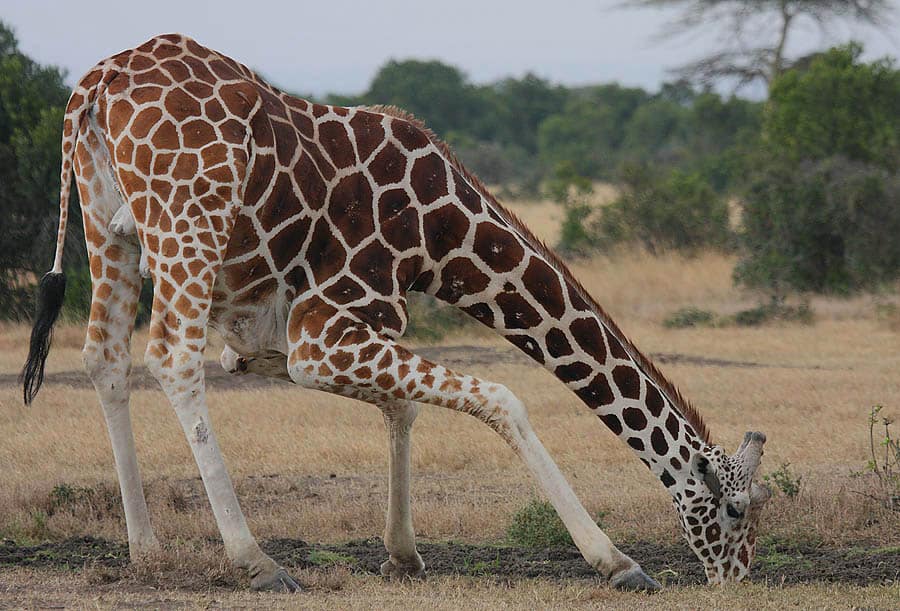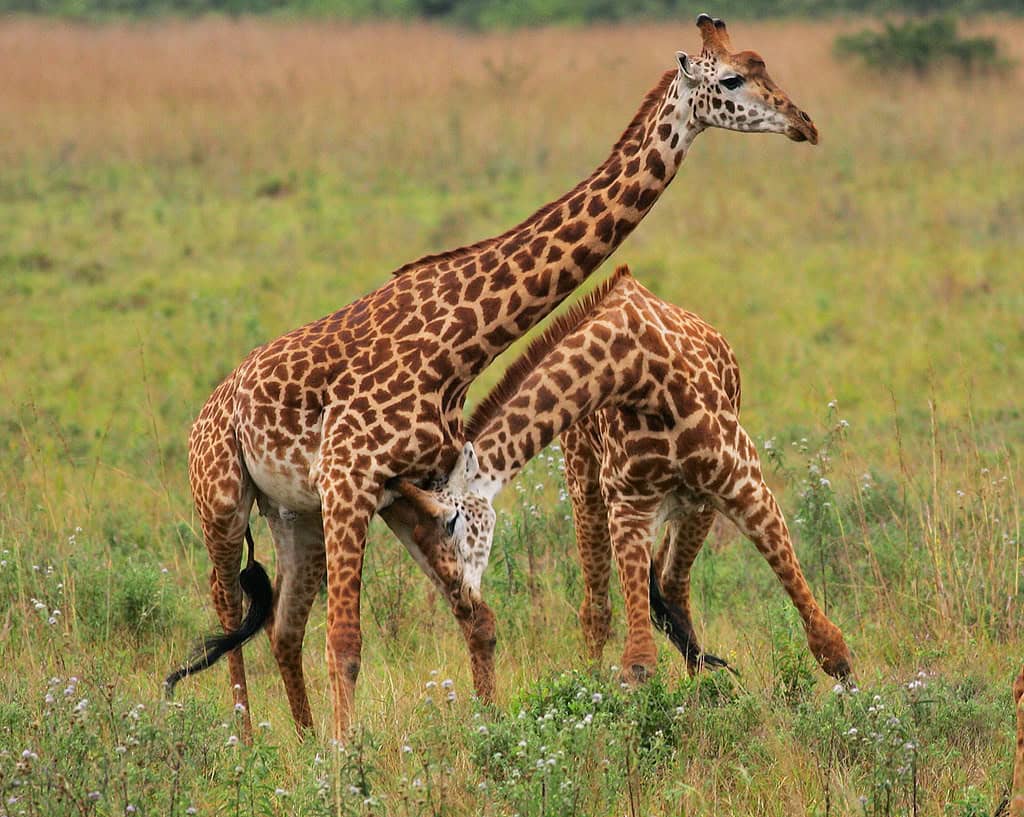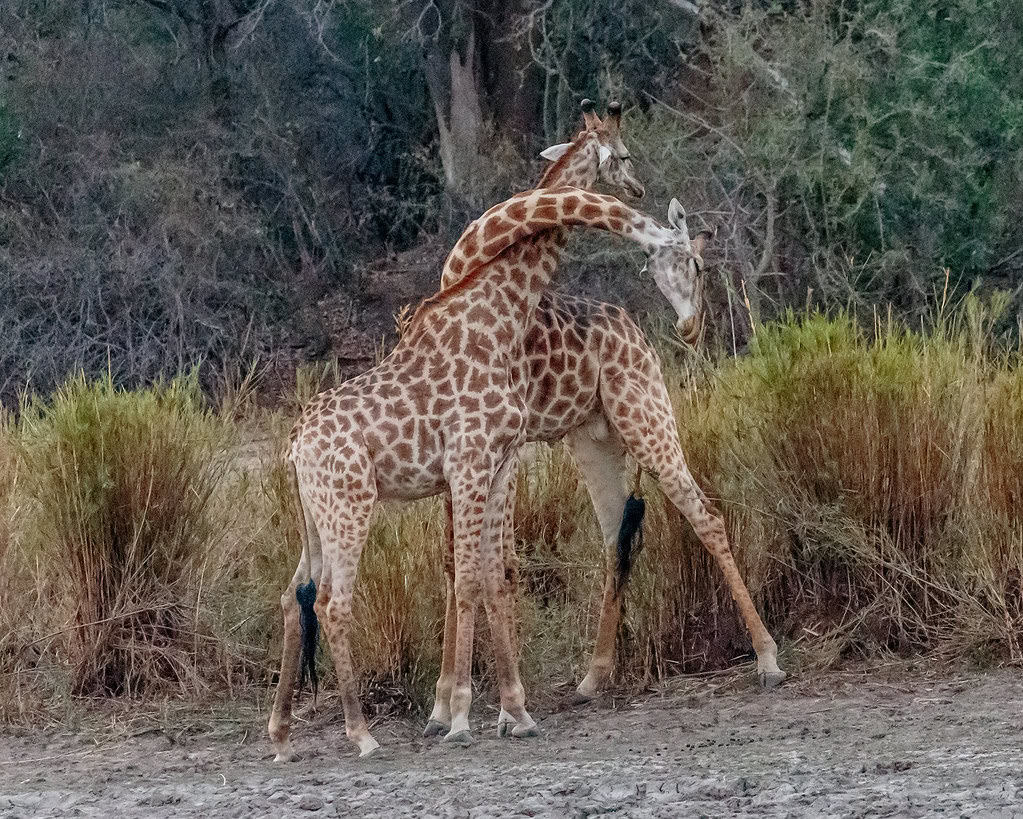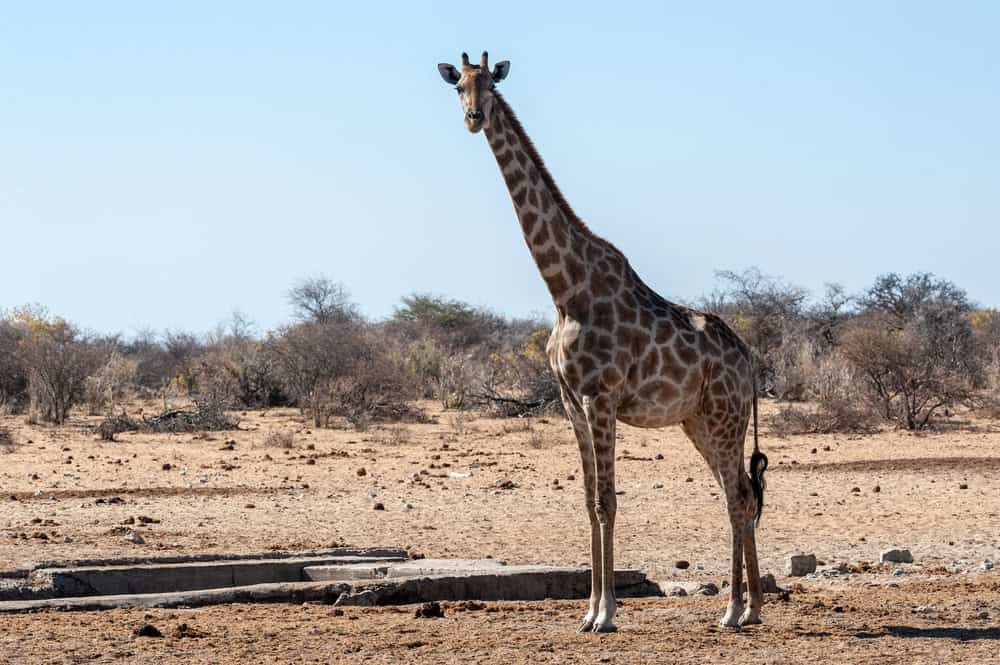In the sprawling savannas of Africa, towering above the acacia trees, giraffes engage in one of nature’s most spectacular combat displays. These gentle giants, known for their graceful movements and peaceful demeanor, occasionally transform into formidable competitors, swinging their six-foot-long necks like biological sledgehammers in what scientists call “necking” battles. These confrontations aren’t random acts of aggression but highly evolved behaviors with specific biological and social purposes. The sight of two adult male giraffes—each potentially standing 18 feet tall and weighing over 3,000 pounds—engaged in a neck-swinging duel is both mesmerizing and somewhat perplexing to human observers. Why would these typically docile herbivores risk injury with such violent confrontations? The answer lies in a fascinating intersection of evolutionary biology, social hierarchy, and reproductive strategy.
The Basics of Giraffe Necking Behavior

Necking is a form of combat unique to giraffes, where two males swing their necks to deliver powerful blows to their opponent’s body. The mechanics are relatively straightforward but impressive: a giraffe will swing his neck to build momentum, then direct his head like a wrecking ball into his opponent’s body, often aiming for vulnerable areas like the legs, flanks, or neck. Despite their gangly appearance, a giraffe’s neck is an incredibly powerful weapon, containing seven highly muscular vertebrae (the same number found in most mammals, including humans, but much larger). The head itself serves as the point of impact, with male giraffes developing bony protuberances called ossicones that are larger and thicker than those of females, providing both weapons and protection during these battles. These contests can last from just a few minutes to more than an hour, with opponents trading blows until one submits by walking away.
Evolutionary Development of Necking

The evolution of necking behavior is intimately tied to the giraffe’s most distinctive feature—their extraordinarily long necks. While the primary evolutionary advantage of the giraffe’s neck is accessing food sources unavailable to other herbivores, natural selection has co-opted this adaptation for competitive purposes. Paleontological evidence suggests that necking behavior likely evolved alongside the elongation of the neck, with fossil records showing the gradual thickening of male giraffe skull bones over evolutionary time. This sexual dimorphism—where males develop thicker skulls and larger ossicones than females—indicates that intrasexual competition has been a significant selective pressure. The evolutionary investment in both offensive capability (neck strength and length) and defensive features (thickened skull bones) demonstrates how important these contests have become in the species’ reproductive strategy. Essentially, giraffes have turned their primary feeding adaptation into a secondary weapon for reproductive competition, showcasing evolution’s opportunistic nature.
The Role of Reproductive Competition

At its core, necking is about reproductive access. Male giraffes engage in these battles to establish dominance hierarchies that determine breeding privileges with receptive females. Giraffes have a polygynous mating system, where dominant males gain access to multiple females. Unlike some mammals that maintain year-round territories, male giraffes practice a reproductive strategy called “roaming.” They travel between different female herds, testing each female they encounter to determine if she’s in estrus (receptive to mating) by performing a behavior called “urine-testing,” where they stimulate urination and then taste the urine to detect hormonal signals. When a receptive female is found, multiple males may compete for breeding rights, leading to necking contests. Research has confirmed that successful males in these contests father significantly more offspring than those who lose, demonstrating the evolutionary importance of this behavior. Essentially, these dramatic battles represent the evolutionary principle that reproductive success often requires direct competition.
The Physics of Giraffe Combat

The biomechanics of necking battles are remarkable from a physics perspective. When a male giraffe swings his neck, he’s wielding an appendage that can weigh over 500 pounds with precision and devastating force. The impact forces generated during these contests have been estimated at over 2,000 pounds of force—equivalent to being hit by a small car. Giraffes have evolved specialized anatomical features to withstand these impacts, including thickened skull bones, reinforced cervical vertebrae, and a complex network of ligaments that help absorb shock. The length of the neck serves as a lever, allowing giraffes to generate tremendous force with relatively modest muscular contractions. Interestingly, giraffes must also solve complex fluid dynamics problems during these battles; their specialized cardiovascular system, which normally regulates blood pressure between their heart and brain across a significant vertical distance, must adapt to rapid changes in head position during combat. This combination of structural adaptation and sophisticated neurological control makes necking one of the most biomechanically complex combat behaviors in the animal kingdom.
Different Types of Necking Behaviors

Researchers have identified several distinct patterns within what’s broadly called “necking.” The most common and dramatic form is high-intensity necking, where giraffes stand side by side and swing their necks horizontally to land blows on their opponent’s body. However, there’s also a low-intensity version sometimes called “sparring” or “necking play,” where younger or less-committed males engage in gentler neck-wrestling contests that involve intertwining necks and pushing rather than striking. These lighter contests seem to serve as practice for younger males and as a way for adults to assess each other’s strength without risking serious injury. A third type, sometimes called “necking display,” involves no physical contact but features males stretching their necks vertically in a dominance display. Researchers believe these different intensities of necking behavior allow giraffes to resolve competitive situations with appropriate levels of investment and risk, depending on the value of the contested resource (such as a highly fertile female) and the relative status of the competitors.
Physiological Adaptations for Combat

Male giraffes possess several specialized adaptations that support their necking behavior. Most notably, bull giraffes develop disproportionately muscular necks compared to females, with some studies showing up to a 30% greater muscle mass. Their skulls also undergo a process called “cranial pachyostosis”—a dramatic thickening of the skull bones that begins at sexual maturity and continues throughout life. Males develop larger, often knobby ossicones (the horn-like protuberances on their heads) that can be used both offensively and defensively. Their skin also thickens significantly, particularly around the neck and shoulders, providing protection against impacts. Additionally, male giraffes develop specialized neuromuscular control systems that allow precise targeting during neck swings. These adaptations aren’t present to the same degree in females, who don’t engage in necking, providing clear evidence that these features evolved specifically to support combat behavior. The metabolic cost of maintaining these combat adaptations is substantial, requiring males to consume approximately 20% more foliage than females of comparable size—a significant investment that highlights the evolutionary importance of competitive success.
The Social Context of Necking

Necking battles don’t occur randomly but are embedded within a complex social context. Adult male giraffes exist largely separately from female-led herds, forming loose bachelor groups or roaming individually. When males encounter each other, especially in the presence of receptive females, they engage in a series of ritualized behaviors that may escalate to necking. These encounters follow predictable patterns, beginning with parallel walking (where males walk side-by-side, assessing each other), followed by necking displays, and potentially escalating to full combat if neither backs down. The social hierarchy established through these contests is relatively stable but requires reinforcement through periodic demonstrations of dominance. Interestingly, after combat, former opponents often engage in reconciliation behaviors, including gentle neck rubbing and standing with their necks crossed. This post-conflict affiliation suggests that maintaining social bonds remains important even among competitors. The presence of females and other males as spectators adds another dimension, as combat performance likely influences a male’s reputation and status within the broader social network, affecting future competitive encounters.
Potential Injuries and Risks

Despite the ritualized nature of necking, these contests carry significant risks. The tremendous forces involved can result in serious injuries, including broken jaws, fractured skulls, broken ribs, and damaged vertebrae. In rare but documented cases, particularly powerful blows have knocked opponents unconscious or even resulted in death. Researchers have observed male giraffes with distinctive scars and healed fractures that likely resulted from past necking contests. Beyond the immediate physical damage, these injuries can have serious secondary consequences; a giraffe with a damaged jaw may struggle to feed properly, while leg injuries compromise mobility and increase vulnerability to predators. Given these risks, giraffes have evolved sophisticated assessment mechanisms to determine when to engage in combat and when to withdraw. These include visual assessments of opponent size, preliminary strength tests through light sparring, and chemical signals that may communicate fighting ability. The fact that giraffes willingly risk such significant injuries underscores the evolutionary importance of establishing dominance for reproductive opportunities—the potential genetic payoff outweighs even severe physical risks.
Age and Experience in Necking Success

Age and experience play crucial roles in determining the outcomes of necking contests. Young male giraffes begin practicing necking behaviors as early as one year of age, engaging in playful sparring with peers that develops coordination and technique without the force of adult contests. Full participation in serious necking battles typically begins around seven years of age, coinciding with sexual maturity. Peak fighting ability is usually reached between 9-12 years of age, when males have developed maximum neck muscle mass and fighting experience. Older males (15+ years) may rely more on established dominance and tactical experience than raw strength as their physical prowess begins to decline. Long-term observational studies have documented that successful males employ sophisticated fighting strategies, including targeting specific vulnerable areas and adapting techniques to counter their opponent’s style. These refined approaches suggest that necking success involves cognitive elements beyond mere physical strength. The combination of physical development, learned techniques, and accumulated experience creates a complex competitive landscape where prime-aged males typically dominate, but where strategic fighting can sometimes allow older males to maintain competitive status beyond their physical prime.
Geographic Variations in Necking Behavior

Fascinating regional differences exist in giraffe necking behavior across the African continent. The intensity and frequency of necking contests vary between the currently recognized four giraffe species (Northern, Southern, Reticulated, and Masai giraffes). Researchers have observed that Masai giraffes in East Africa tend to engage in particularly intense necking battles, while Northern giraffes in West and Central Africa appear to resolve more conflicts through displays rather than direct combat. These differences may relate to habitat variations, population density, or genetic predispositions. In areas with higher giraffe density and more concentrated breeding seasons, competition intensifies, resulting in more frequent and vigorous necking contests. Conversely, in regions where predator pressure is higher, giraffes may moderate combat intensity to avoid injuries that would increase predation vulnerability. Some researchers have also noted subtle differences in fighting techniques between populations, suggesting the possibility of cultural transmission of fighting styles within regional groups. These geographic variations provide valuable insights into how ecological factors shape the expression of this behavior and how competition strategies adapt to local conditions.
Observation and Research Challenges

Studying giraffe necking behavior presents unique challenges for researchers. The behavior occurs unpredictably and relatively infrequently, with serious contests sometimes separated by weeks or months even during breeding seasons. The vast home ranges of giraffes—sometimes exceeding 75 square miles—make consistent observation difficult, requiring researchers to invest thousands of hours of field time to document sufficient examples. Additionally, the presence of human observers may alter natural behavior patterns, particularly in regions where giraffes have learned to associate humans with danger. Modern research has employed innovative techniques to overcome these challenges, including GPS tracking collars to locate individuals, remote camera traps to capture interactions without human presence, and even drone technology to observe from above without disturbing the animals. Citizen science has also played an increasing role, with safari guides and tourists contributing valuable video documentation of necking behaviors that might otherwise go unrecorded. Despite these advances, many aspects of necking remain understudied, particularly regarding how early development influences adult fighting ability and the long-term physical consequences of repeated combat throughout a male’s lifetime.
Necking in Popular Culture and Conservation Awareness

Giraffe necking battles have captured human imagination, appearing in nature documentaries, wildlife photography, and even inspiring scenes in animated films. These dramatic confrontations provide a compelling window into wild animal behavior that helps generate public interest in giraffe conservation. Unfortunately, this heightened visibility hasn’t translated into adequate protection; giraffe populations have declined by approximately 40% over the past three decades, primarily due to habitat loss and poaching. Some conservation organizations have strategically used images and footage of necking battles in awareness campaigns, highlighting the complex behaviors that could be lost if giraffe populations continue to decline. Interestingly, the fascination with necking has sometimes led to misconceptions, with some popular media incorrectly portraying the behavior as primarily aggressive rather than reproductive in nature. Conservation education efforts now frequently include accurate information about necking behavior to foster a deeper appreciation for giraffe behavioral ecology. By connecting people emotionally to these magnificent animals through their distinctive behaviors, conservationists hope to build stronger public support for habitat protection initiatives and anti-poaching efforts across Africa.
Conclusion: The Evolutionary Significance of Necking

Giraffe necking represents one of nature’s most remarkable examples of how evolution can repurpose adaptations for multiple functions, transforming a feeding adaptation into a sophisticated combat system. These dramatic battles, with their combination of raw power and strategic finesse, reveal the extraordinary lengths to which natural selection will go to solve the fundamental challenge of reproductive competition. By studying necking behavior, we gain insights not just into giraffe biology but into broader evolutionary principles regarding sexual selection, conflict resolution, and the development of specialized adaptations. As giraffe populations face increasing threats across their range, understanding behaviors like necking becomes even more important for conservation efforts, helping us appreciate what would be lost if these magnificent animals disappeared. The continued existence of these towering duelists depends on our ability to protect their habitats and ensure that future generations can witness the spectacular sight of two male giraffes engaged in one of nature’s most impressive tests of strength and determination.
- This Bird Migrates 12,000 Miles Without Landing Once - August 18, 2025
- The World’s Dumbest Animals You Won’t Believe How Silly They Are - August 18, 2025
- Do Animals Dream? What Research Reveals - August 18, 2025

